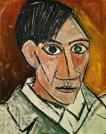
Horace Vernet
How from talented and prestigious painters passed by Montmartre for revolutionner the history of painting! This adventure commençe with the XIX° century
Very early the painters emigrate on the hillock. Already in 1820 Horace Vernet lives Chaussée Martyrs where it paints between two marines the Barrier of Clichy. He is the neighbor of Géricault, ignored painter of general public but already recognized by his pars. Géricault, the painter of the Raft of the Jellyfish settled in Montmartre. That will be fatal for him, because one day proudly passing with horse with the barrier Martyrs, "his box with color fixed on the pommel of its saddle" and looking at too attentively some Mimi Finch of the suburbs, it makes a bad fall. Condemned during years to the immobility, he dies on January 18, 1824.
.

Horace Vernet
Corot is installed on the hillock about 1830. It carries out the Mill of Wafer there. It is with the Street Saint-Vincent and the Tower of the Telegraph, one of the major works devoted to Montmartre. Its first fabrics are the signs heralding a great movement which will occur later on the fringes of 18th, in Batignolles
Les impressionnistes
It is towards 1850 that the independent artists, under the crook of Manet, take the practice to meet with the Guerbois coffee, 9, Main street of Batignolles, now which occurred of Clichy, in 17th. Under the smoked out ceilings of the room of the first stage find themselves impressionist painters like Bazille, Renoir, Claude Monet, Pissaro, Cézanne and Degas, of return of Italy
.
After the war of 1870, the impressionist group emigrated in a new coffee which passed thanks to him to the posterity under the name of the Athens News, 9, Pigalle place, in 9th. The establishment was very attended and while his/her comrades spoke between them, Degas crunched the customers who presented themselves. Of its search it left us a series of tables of a psychological accuracy and a pictorial quality inimitable. Thus it is Women with the coffee or of famous Absinthe.
At this time the impressionist group is in full rise. In Manet, in Degas comes soon to join Renoir coldly arrived on the hillock. Renoir settles in an old home of the street Cortot and division its days between this one and the Mill of Wafer where it works the afternoon with its large fabric of the ball.
Reception Montmartre

Van Gogh
While Renoir moves away, another painter replaces it, coming from north. He is called Van Gogh. In contact with Montmartre and of her artists, Van Gogh modified her way of painting. It left the fogs of north finally to discover the glare of the light. It is there that it was released from its first manner to return to a pure painting, detached of any social or religious ideology. Its pallet has already tone scintillating. Its blue becomes deeper; its yellows subtly are gilded. It is in Montmartre that its painting is released.
Already it hesitates between stridencies of the expressionnism and silences of the abstraction

Toulouse-Lautrec
It was installed on the hillock but often moved. After several emergency dwellings, it bourgeoisement settled street Caulaincourt, to the 21 which it then leaves for the Frochot avenue. Painter society man, Toulouse-Lautrec haunts all the à.la.mode places: balls, circuses, café concerts. But its headquarters remain the Moulin-Rouge.
That paintings, that drawings the Moulin-Rouge inspired to him! To start with the poster which the directors of the establishment ordered to him in 1891. Lautrec was here in its element. It daily côtoyait strange characters with the sometimes turbid and flattering reputation: Goulue, boned Valentine, the Kid cheese, Grid of sewer and gold Ray.
By the boldness of the feature and the innovation of the color, it escaped from the impressionist school in which one wanted to lock up it.

Picasso
Soon the painters of the Beautiful Time succeed of other artists whose mentality diverts and anxious. It is not a question any more of expressing the softness of living but revolutionizing art. Spanish with the cowlick and to the savage glance goes up to Paris to change the face of the world: it is called Pablo Picasso. Andalusian of origin, it will be Montmartrean of adoption. Doesn't each time that it comes to Paris, go down on the hillock? During its fourth voyage, it finishes in 1912 by moving in with the n°13 of the street Ravignan (currently place Emile Goudeau) in a strange entirely made shack of boards: the Boat wash-house. It is there that Picasso will live decisive years in discomfort more extrême.
During the autumn 1907 it made there discover "the Young ladies of Avignon" chief of work of the movement cubist.

|
............ |
The main painters of Montmartre
| Géricault - Michel | Van Gogh |
| Corot-Gavarni | Bernard |
| Cézanne | Seurat |
| Pissarro | Signac |
| Renoir | Valadon - Utrillo |
| Manet | Modigliani |
| Degas | Picasso |
| Caillebotte | Van Dongen |
| Toulouse Lautrec | Dufy |
| Bonnard | Poulbot |
| Tzara-Gris-Gen | Willette |
| Brascassat-Jongkind | Bottini-Gill-Forain |